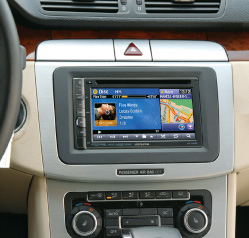Categories
- Bebb Beds Rock N Roll VW T4/T5 Camper beds
- Vehicle CCTV
- Bluetooth Phone Kits
- Fitted Handsfree phonekits
- Factoryfitted Bluetooth Upgrades
- Phone Holders and Cradles
- DAB Digital Radio
- Ipod Intergration
- Headunits
- Amplifiers
- Speakers
- Subwoofers
- Navigation
- Speed Camera Location Systems
- Accessories
- OEM Interface
- Package deals
- Processors
- Comercial/High Roof Vehicles,Coach and Bus.
- Camping, Caravan, Motorhome, Outdoor GPS
- Vehicle finder
Popular Brands
Our Newsletter
Navigation
Mega watt has been installing sat navs for over 15 years, we can show you all the options from a simple portable navi to a fully integrated factory looking DVD touch-screen system with ipod and bluetooth built in.

What is Sat Nav
Satellite navigation brings Space Age technology into your daily life. Forget paper maps, Using the Global Positioning System (GPS), you can sit at the wheel of your car and be guided from A to B without the hassle of pulling over to read a map or ask for directions
How it Works
A sat nav unit is a receiver linked to a network of satellites orbiting the Earth. The satellites help the receiver to pinpoint its precise position on the surface of the Earth, to within a few metres. this information added to the stored maps on the device and some computer technology is all that is needed for your sat nav can guide you anywhere you want to go. and where possible right to the house/location number.
Inputting your destination
Before you begin your journey, you have to program your sat nav unit, to tell it where you want to go. You do this by identifying your destination, by keying in the address, usually by pointing to the keypad on the touch-screen. The more precise the address, the more precise the directions, and the best the way to identify an address is to use the full seven-digit postcode, if your sat nav unit will accept this. Once it knows your destination, the sat nav will calculate to quickest route to get there - but if you prefer, you can always choose another route by inputting various 'waypoints' that the route should take you to, or by identifying roads that you wish to avoid ('road exclusion').
Voice directions
When you get going, your sat nav unit will anticipate the manoeuvres that you have to make by talking to you: 'Take the next left', 'After three hundred yards, at the roundabout, take the third exit', and so on.
Map presentation
Meanwhile, the screen will show your changing position on a map of the immediate locality. This might be a 2D (two-dimensional) map, which gives you an overhead view, like a traditional paper map. But most sat nav units now use '3D mapping', which provides a schematic, angled view of the route ahead of you, as if seen from the air; this makes it easier to visualise your next move along the way. The screen will also constantly update written data about your journey, such as your next instruction, your speed, speed limits in the area, your estimated time of arrival, the name of the street you are currently in, and so on.




